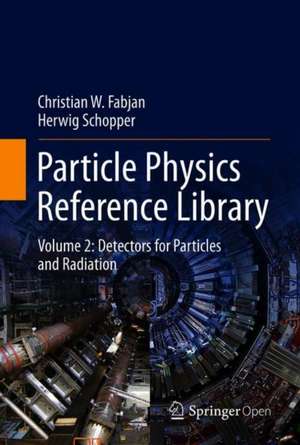Particle Physics Reference Library: Volume 2: Detectors for Particles and Radiation
Editat de Christian W. Fabjan, Herwig Schopperen Limba Engleză Hardback – 2 sep 2020
A joint CERN-Springer initiative, the “Particle Physics Reference Library” provides revised and updated contributions based on previously published material in the well-known Landolt-Boernstein series on particle physics, accelerators and detectors (volumes 21A,B1,B2,C), which took stock of the field approximately one decade ago. Central to this new initiative is publication under full open access.
| Toate formatele și edițiile | Preț | Express |
|---|---|---|
| Paperback (1) | 466.95 lei 6-8 săpt. | |
| Springer International Publishing – 18 sep 2020 | 466.95 lei 6-8 săpt. | |
| Hardback (1) | 475.06 lei 6-8 săpt. | |
| Springer International Publishing – 2 sep 2020 | 475.06 lei 6-8 săpt. |
Preț: 475.06 lei
Nou
Puncte Express: 713
Preț estimativ în valută:
90.90€ • 99.05$ • 76.60£
90.90€ • 99.05$ • 76.60£
Carte tipărită la comandă
Livrare economică 24 aprilie-08 mai
Preluare comenzi: 021 569.72.76
Specificații
ISBN-13: 9783030353179
ISBN-10: 3030353176
Pagini: 862
Ilustrații: IX, 1078 p. 546 illus., 345 illus. in color.
Dimensiuni: 155 x 235 x 65 mm
Greutate: 1.68 kg
Ediția:1st ed. 2020
Editura: Springer International Publishing
Colecția Springer
Locul publicării:Cham, Switzerland
ISBN-10: 3030353176
Pagini: 862
Ilustrații: IX, 1078 p. 546 illus., 345 illus. in color.
Dimensiuni: 155 x 235 x 65 mm
Greutate: 1.68 kg
Ediția:1st ed. 2020
Editura: Springer International Publishing
Colecția Springer
Locul publicării:Cham, Switzerland
Cuprins
Chapter 1. Introduction.- Chapter 2. The Interaction of Radiation with Matter.- Chapter 3. Scintillation Detectors for Charged Particles and Photons.- Chapter 4. Gaseous Detectors.- Chapter 5. Solid State Detectors.- Chapter 6. Calorimetry.- Chapter 7. Particle Identification: Time-of-Flight, Cherenkov and Transition Radiation Detectors.- Chapter 8. Neutrino Detectors.- Chapter 9. Nuclear Emulsions.- Chapter 10. Signal Processing for Particle Detectors.- Chapter 11. Detector Simulation.- Chapter 12. Triggering and High-Level Data Selection.- Chapter 13. Pattern Recognition and Reconstruction.- Chapter 14. Distributed Computing.- Chapter 15. Statistical Issues in Particle Physics.- Chapter 16. Integration of Detectors Into a Large Experiment: Examples From ATLAS andCMS.- Chapter 17. Neutrino Detectors under Water and Ice.- Chapter 18. Space Borne Experiments.- Chapter 19. Cryogenic Detectors.- Chapter 20. Detectors in Medicine and Biology.- Chapter 21. Solid State Detectors for HighRadiation Environments.- Chapter 22. Future Developments of Detectors.
Notă biografică
Christian Fabjan is an experimental particle physicist, who spent the major part of his career at CERN, with leading involvement in several of the major CERN programmes. At the Intersecting Storage Rings he concentrated on Strong interaction physics and the development of new experimental techniques and followed at the Super Synchrotron with experiments in the Relativistic Heavy Ion programme. At the Large Hadron Collider he focused on the development of several experimental techniques, and participated to the ALICE experiment as Technical Coordinator. He is affiliated with the Vienna University of Technology and was, most recently, leading the institute of High Energy Physics of the Austrian Academy of Sciences.
Herwig Franz Schopper joined as a research associate at CERN since 1966 and returned in 1970 as leader of the Nuclear Physics Division, and went on to become a member of the directorate responsible for the co-ordination of CERN's experimental programme. He was chairman of the ISR Committee at CERN from 1973 to 1976 and was elected as member of the Scientific Policy Committee in 1979. Following Léon Van Hove and John Adams' years as Director-General for research and executive Director-General, Schopper became the sole Director-General of CERN in 1981.
Schopper's years as CERN's Director-General saw the construction and installation of the Large Electron-Positron Collider (LEP) and the first tests of four detectors for the LEP experiments. Several facilities (including ISR, BEBC and EHS) had to be closed to free up resources for LEP.
Herwig Franz Schopper joined as a research associate at CERN since 1966 and returned in 1970 as leader of the Nuclear Physics Division, and went on to become a member of the directorate responsible for the co-ordination of CERN's experimental programme. He was chairman of the ISR Committee at CERN from 1973 to 1976 and was elected as member of the Scientific Policy Committee in 1979. Following Léon Van Hove and John Adams' years as Director-General for research and executive Director-General, Schopper became the sole Director-General of CERN in 1981.
Schopper's years as CERN's Director-General saw the construction and installation of the Large Electron-Positron Collider (LEP) and the first tests of four detectors for the LEP experiments. Several facilities (including ISR, BEBC and EHS) had to be closed to free up resources for LEP.
Textul de pe ultima copertă
This second open access volume of the handbook series deals with detectors, large experimental facilities and data handling, both for accelerator and non-accelerator based experiments. It also covers applications in medicine and life sciences.
A joint CERN-Springer initiative, the “Particle Physics Reference Library” provides revised and updated contributions based on previously published material in the well-known Landolt-Boernstein series on particle physics, accelerators and detectors (volumes 21A,B1,B2,C), which took stock of the field approximately one decade ago. Central to this new initiative is publication under full open access.
A joint CERN-Springer initiative, the “Particle Physics Reference Library” provides revised and updated contributions based on previously published material in the well-known Landolt-Boernstein series on particle physics, accelerators and detectors (volumes 21A,B1,B2,C), which took stock of the field approximately one decade ago. Central to this new initiative is publication under full open access.
Caracteristici
Reviews the state of the art in detector physics and related data-taking technology Provides open access to previously published material which has been revised and updated Edited and authored by leading researchers in the field
